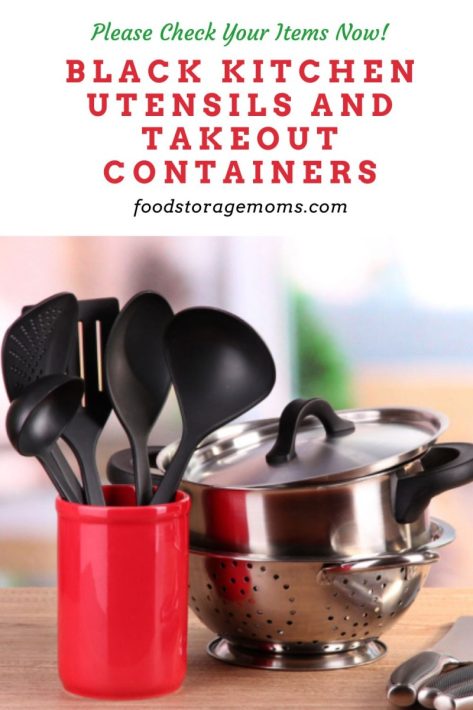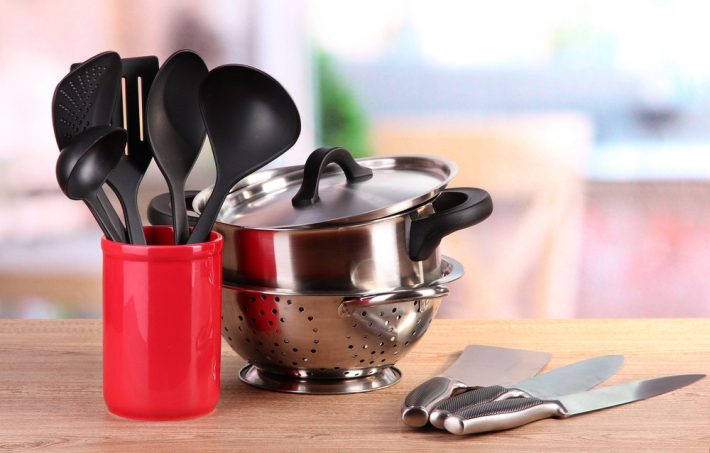
We may want to think twice about our black kitchen utensils and takeout containers. After reading and researching the safety of these items, I realized we might need to rethink what we are using or what is safe to reuse in our kitchens. Are they safe to use? Please keep in mind that I am not a microbiologist or scientist. Let’s talk about these items today.
We have one of the best Chinese restaurants in northern Utah, the Mandarin, a beautiful place to eat. You have to get there half an hour before it opens, or you will have to wait about two hours to get a table. I’m not very patient when I’m hungry and waiting outside in the cold in Bountiful, Utah.

My point today is that some restaurants, when you get take-out food or doggy containers for your leftovers, have excellent white paper containers, but some have these black plastic containers with clear tops. Recent social media attention has focused on studies indicating that black plastic products, including black plastic containers and the black utensils used to fill them, may be toxic. Let’s discuss this issue so you can make informed decisions about dealing with these plastic products.
Stainless Steel Kitchen Utensils
Black Kitchen Utensils And Takeout Containers
I spend much of my day in the kitchen and have done for years. We’ve collected many kitchen-specific tools to make meal preparation, food storage, and meal serving much more effortless. I tend to take each of those tools for granted, including where I got them, how to use them, and how to take care of them.
I watch use-by dates, expiration dates, and the general condition of food products in my refrigerator and freezer to ensure our food is safe.
It wasn’t until recently that I heard there may be some unnecessary toxic exposure for me and my family when I use items made from black plastic. What is the history here, and how should we respond to various studies to determine potential health risks and minimize those health risks in our homes?
Exposure to Toxic Chemicals
Studies in recent years have shown that black plastic often contains toxic flame retardants. A key element in these plastic items is bromine, which is used to make brominated flame retardants (BFRs). BFRs are added to products like plastic electronics since these products generate heat that could make them more flammable.
The BFRs have proven to be cancer-causing chemicals that can also affect brain development in younger people, along with other health issues.
Although the use of these toxic flame retardants has been banned in the U.S. since 2021, many black plastic items still contain flame retardant chemicals due to plastic recycling issues and because we have older items in the kitchen. We all would like to see a reduction in plastic waste currently filling our local landfills, and we try to do our part by recycling these products.
The challenge comes when the recycling facility mixes plastic electronics with other materials. Thus, the manufacturers aren’t adding hazardous chemical materials; they are receiving contaminated plastic through regular supply chains. Many modern electronic devices like laptops, PCs, headphones, and TVs use plastic to save money and weight and don’t tend to heat up as much. That’s why we see so many devices in our landfills and recycling centers when they wear out or become obsolete.
Many recycling facilities try to restrict black plastic from household items. Still, the carbon used to color the plastic black limits the sorting equipment’s ability to recognize it as plastic, so it gets mixed with plastic electronics.
Black Plastic Silverware
Many food connoisseurs are alarmed by a recently published article in Chemosphere. The article outlines many black plastic objects that could prove harmful to your health. The items they found that tend to have high levels of harmful chemicals are common black plastic items in your household, like plastic silverware, children’s toys, black food trays, black plastic kitchen utensils like spatulas, and even a sushi tray from your local restaurant.
You may wonder why children’s toys can be an issue since there isn’t any ingestion. The challenge comes from the kids having continual contact with the toys for hours, their hands getting hot and sweaty, and then putting their fingers in their mouths. The risk may seem slim, but tests as part of international studies have shown a transfer of the harmful chemicals through children’s regular play as they leach onto their skin and then mix with saliva.

Black Containers For Meal Prep and Food Delivery
This post should serve as a warning to use caution when any of your food is exposed to black plastic, including black containers used to serve food in any venue. That would include school cafeterias, buffet lunch settings in delis or grocery stores, or when taking home restaurant food items.
If you are given a black food container to take your food home, be sure to transfer the food to another container as soon as possible. Since heating the food in that container as a leftover can cause it to absorb harmful chemicals, never use the black container to reheat the food.

Black Kitchen Utensils In Your Kitchen
We’ve had our food prep and serving utensils for years. Some are white or grey, but we have black pancake turners, large serving spoons, and spatulas, similar to the picture below. We’ve ordered new items from Amazon for delivery this week, so we don’t have to use household items that may contain carcinogens. We’ll throw these items out with the trash rather than putting them in our recycle bin since we don’t want to pass our possibly contaminated items on to anyone else.

What Are Some Good Options As Replacements for These Black Plastic Items?
I’ve been telling my readers for years to look for BPA-free containers. Many plastic containers will state they are BPA-free and will provide a rating number on the bottom. Most clear plastic containers should be BPA-free, but if you have questions, check with the manufacturer before you make any significant purchases.
An option is to consider shifting your storage containers to glass. They are definitely BPA-free, can be used in your freezer, work well when reheating with a microwave, and more. Yes, there are issues with breakage, but the benefits outweigh the downside, from my perspective.
Some well-known and respected brands to prioritize your purchases are:
- Anchor Hocking
- Ball and Kerr (mason jars)
- OXO
- Rubbermaid
- Pyrex
Final Word
I hope you enjoyed my post about black kitchen utensils and plastic containers today. I love learning new things and feel strongly I need to share this information with you. May God Bless this world, Linda
Copyright Images: Black Containers For Meal Prep AdobeStock_310237485 By Foodandcook, Black Plastic Forks and Spoons Depositphotos_289653442_S By VladislavChusov, Black Kitchen Utensil On Table Depositphotos_20165599_S By Belchonock
The post Black Kitchen Utensils And Takeout Containers (Are They Safe?) appeared first on Food Storage Moms.
from Food Storage Moms
No comments:
Post a Comment